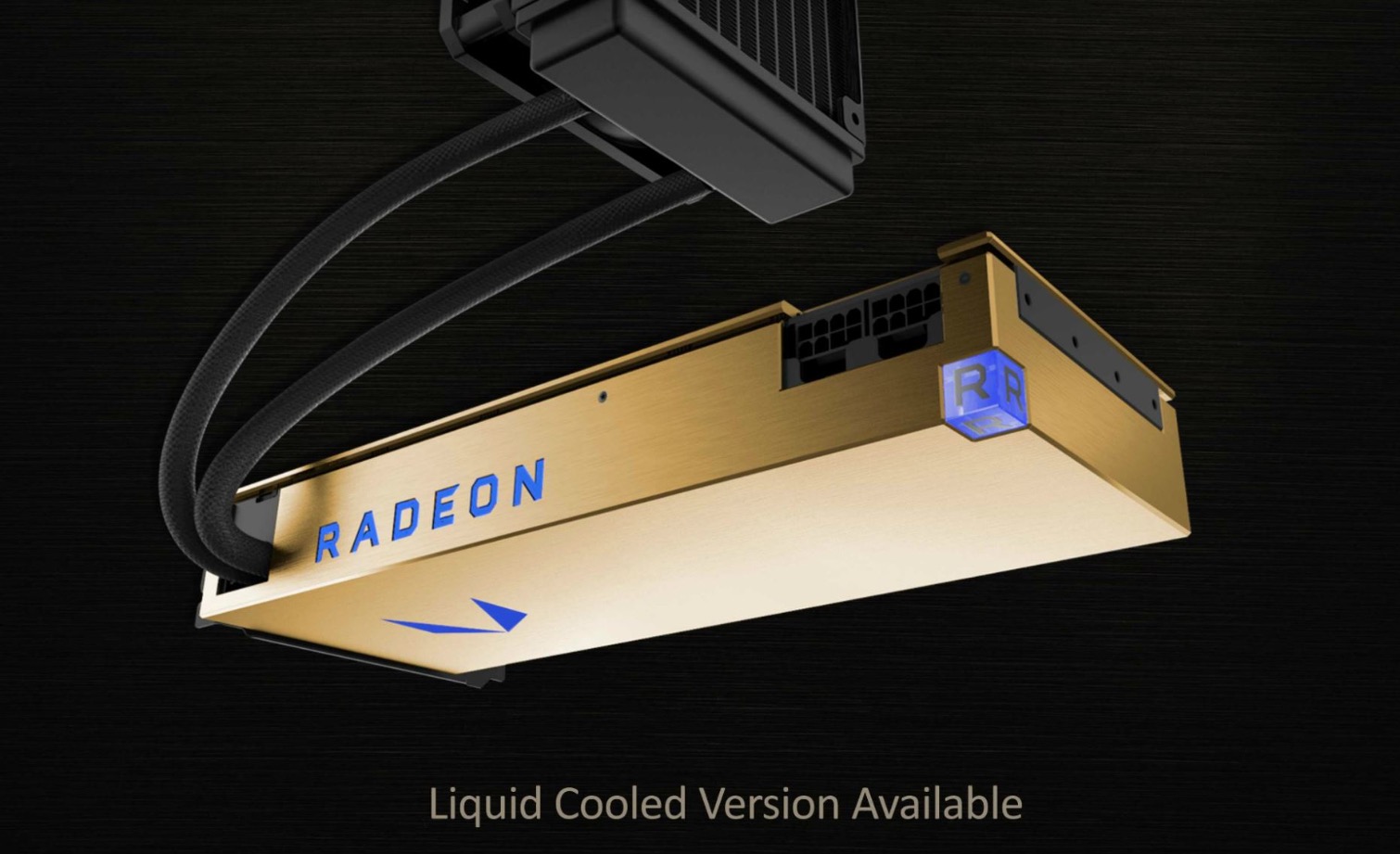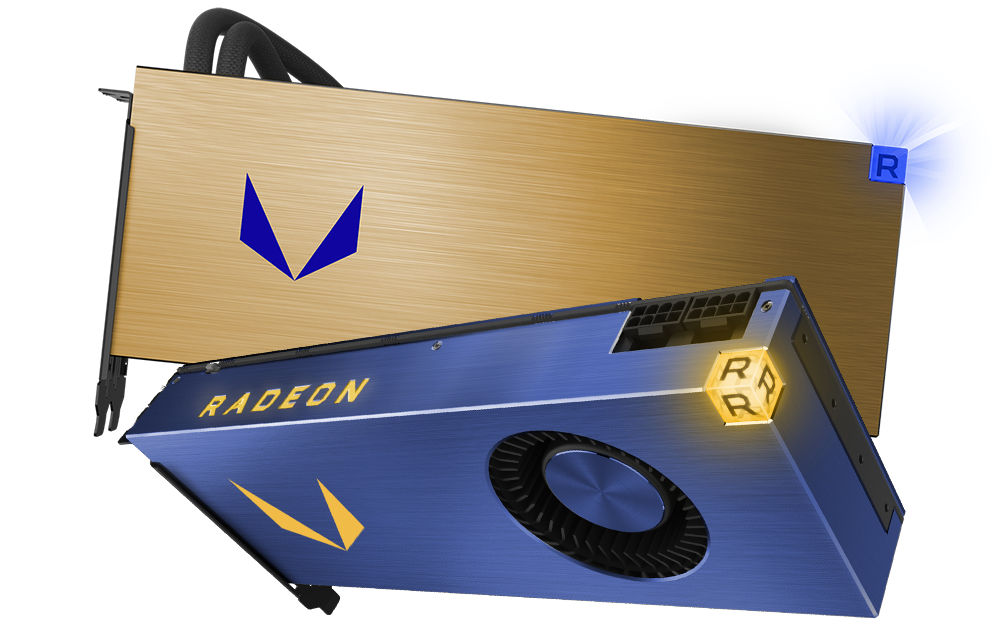AMD’s Liquid-Cooled Vega Frontier Edition Available For $1,490
AMD recently launched the air-cooled Vega Frontier Edition graphics card. Now the liquid-cooled version is ready. At least one online retailer (SabrePC) has them in limited stock.
It’s been a long wait for AMD’s Vega GPU architecture. The company revealed that Vega would launch in 2017 all the way back in March 2016. That was before the company revealed that the Polaris architecture would precede Vega and sidestep the high-end GPU market in favor of the high-volume mainstream market. With nothing to compete against Nvidia’s high-end offerings, AMD fans continue to wait for enthusiast-class Vega GPUs.
We’re still not sure when we’ll see a consumer product based on Vega. AMD is putting its top silicon to work for the scientific community first. AMD launched the Vega Frontier Edition on June 27 at a price tag of $999, which would be out of reach for most gamers, but not out of reach for researchers in fields such as artificial intelligence and machine learning.
Large companies and research institutions are investing heavily in these two emerging technologies, and $1,000 is a bargain compared to some of Nvidia’s enterprise-class Tesla cards. In fact, AMD is betting that $1,000 is such a bargain that companies won’t balk at a 50% price bump in exchange for better cooling potential, quieter operation, and presumably a higher clock speed. The liquid-cooled card features the same core count as the air-cooled variant, but you’ll have to shell out at least $1,490 for it.
At the end of June, when AMD started taking orders for the air-cooled Vega Frontier Edition, the company said that the water cooled version would ship in Q3. We expected a longer delay, but this week we found listings at SabrePC and Newegg.com.
AMD's website and the two sale listings don't list the operating frequency of the liquid-cooled version of the Vega Frontier Edition, though it carries a higher TDP rating of 375W (up from 300W for the air-cooled card). If we use AMD’s Fiji cards as an example, we can infer that the liquid-cooled Vega would have a somewhat higher clock speed. The water-cooled, full-featured Fury X has a TDP of 275W, whereas the trimmed down R9 Nano features the same core with a slightly lower clock speed but draws 100W less power.
| Specifications | Radeon Vega Frontier Edition Liquid Cooled | Radeon Vega Frontier Edition |
|---|---|---|
| Brand | AMD | AMD |
| Model | 100-506062 | 100-506061 |
| Type | Workstation/Desktop | Workstation/Desktop |
| Chipset Manufacturer | AMD | AMD |
| Code Name | Vega | Vega |
| GPU | Radeon Vega Frontier Edition | Radeon Vega Frontier Edition |
| Memory Size | 16GB | 16GB |
| Memory Type | HBC | HBC |
| Memory Bandwidth | 483 GBps | 483 GBps |
| Stream Processors | 4,096 | 4,096 |
| Core Clock | TBA | 1382MHz |
| Peak Core Clock | TBA | 1600MHz |
| Interface | PCI-E 3.0 x16 | PCI-E 3.0 x16 |
| Overclocked | No | No |
| Single Precision Peak Floating Point | 13.1 TFLOPS | 13.1 TFLOPS |
| Double Precision Peak Floating Point | 26.2 TFLOPS | 26.2 TFLOPS |
| Low Profile | Yes | Yes |
| Cooling Type | Liquid Cooled | Active Fan |
| API Support | DirectX 12.1, OpenGL 4.5, OpenCL 2.0, Vulkan 1.0 | DirectX 12.1, OpenGL 4.5, OpenCL 2.0, Vulkan 1.0 |
| Max Resolution | TBA | TBA |
| Outputs | 3x DisplayPort 1.4 HBR3/HDR Ready, 1x HDMI 4K60 | 3x DisplayPort 1.4 HBR3/HDR Ready, 1x HDMI 4K60 |
| Form Factor | Dual-slot, full length | Dual-slot, full length |
| TDP | 375W | 300W |
Get Tom's Hardware's best news and in-depth reviews, straight to your inbox.
Kevin Carbotte is a contributing writer for Tom's Hardware who primarily covers VR and AR hardware. He has been writing for us for more than four years.
-
10tacle ReplyWe’re still not sure when we’ll see a consumer product based on Vega. AMD is putting its top silicon to work for the scientific community first.
AMD would have to be complete idiots to not do that. They have not had a high end Ti Nvidia competitor since the Fury X took on the 980Ti (and even that was largely a fail after all the hype of being a 980Ti killer). I've been reading that Nvidia is going to do a Pascal 10xx refresh to 20xx to tide everyone over until the consumer Volta next year (GTX 30xx), but I haven't read any confirmation of that that is credible.
The last time Nvidia did that was with Kepler and 6xx to 7xx, which really only gained about 10% except the intro of the new GTX 780 which was a cut down GK110 Titan ($650 sure beat $1,000 for 90% plus of the performance). AMD needs to hit Nvidia in the high end GPU market like they did with CPUs taking on Intel with Ryzen. Higher end GPUs offer higher profit margins.
AMD has focused mostly on the low hanging fruit sales except the 570/580. With more buyers going 4K these days or G-sync 1440p monitors requiring massive GPU power, if they fail to do make consumer level Vegas, it will be their market loss. -
redgarl The AIO cost easily 100$ + 100-150$ for the heatsink. Sure, they ask for a prenium, but it's far from a 400$ profit.Reply -
redgarl 10tacle... all the 470, 480, 570 and 580 are sold out. They didn't do a misztake. IF Vega architecture excel in mining, like the early reports seems to indicate, they will sell easily. I heard something around 40-50 hash rate which is almost twice as much as the other cards.Reply -
10tacle Reply19940568 said:10tacle... all the 470, 480, 570 and 580 are sold out. They didn't do a misztake. IF Vega architecture excel in mining, like the early reports seems to indicate, they will sell easily. I heard something around 40-50 hash rate which is almost twice as much as the other cards.
Who said anything about AMD making a mistake? Note I'm talking about a Ti-level GPU competitor for Vega, not lower tier say RX 670 and RX 680 Vegas here (or whatever AMD will label them). Miners are not targeting high end GPUs for the obvious reason of cost/ROI.
My point, and I guess it wasn't clear, is that AMD needs to get back in the game of the Fury X and compete against Nvidia's Ti class (again, not that it was really competitive with the 980Ti). If memory serves me correctly, the 980Ti and Fury X were both $650 (USD) GPUs. -
grozzie Have been waiting for a desktop VEGA for nearly a year! When are you going to deliver. RX580 doesn't really cut it anymore.Reply -
clonazepam I don't think AMD needs to swoop in and steal the high-end until 2019-2020 when adoption of 4K is expected to reach 50%. From what I understand, 1440p and 4K are still 2% and below. The young generation today buying the inexpensive cards are the big spenders of tomorrow. Now's the time to build the base, build the driver team, and have a complete platform ready in a year or two.Reply
2019-2020 would also see a console refresh, most likely, to also have something actually capable of 4K.
I'd like to see AMD really take their time on this. Intel is also making a big play in the e-sports market, which also happens to appeal to those buying the lower end parts. That is the play right now, that's the battleground. Win the war later. -
nandrei @Tech2020, you have no idea what you are talking about. If you did, then hopefully you'd not have spread such ignorance.Reply
https://www.youtube.com/watch?v=oSZz6xoooAw -
So far the air cooled Frontier Edition performs almost identically to my 980 Ti in the Unigine benchmarks ( Superposition and Valley ). I was actually almost shocked how well my 2 year old card did against it. This is the same 980 Ti I've been thinking about selling to get a GTX 1080 for my 1440p 60Hz screen. Am I missing something in that we're talking about a $1500 GTX 1070-1080 that uses 375 watts here? It's the same silicon right? Like their might be some driver improvements as always with AMD but best case it's going to compete with a GTX 1080? For $1500?Reply
I'm sure I'll get downvotes for questioning the almighty AMD but I really don't understand these cards. -
USAFRet Reply19944214 said:
I'm sure I'll get downvotes for questioning the almighty AMD but I really don't understand these cards.
They need a $1500 GPU, just so they can say they have a $1500 GPU.
Does not matter that it does not perform 'a lot' better than anything else. Just has to be 'a little' better.
Just like that $1200 Titan Xp thing. A flagship, that only a few clueless will buy. -
They needed this card a year ago. At 1/3 the price.Reply
On some level the Titan XP makes sense. A very high level to be sure but the Titan XP is hands down the fastest single card you can buy. For $1200 you get a card more than 30% faster than the $1500 Vega. Or you could get a pair of 1080 Ti cards for $1500.....I'm not faulting AMD for not beating the high end Nvidia cards. Ryzen had to have eaten most of their R&D budget and they wanted to stick with HBM which hasn't lived up to the early hype thanks to cheaper GDDR5X and soon to come GDDR6. It's the price that confuses me.

